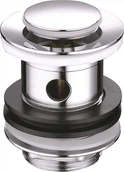Hey there! I'm in the sink drain supply business, and I often get asked, "Do I need a plumber to replace a sink drain?" Well, let's dive right into this topic and figure out what's the deal.
First off, let's talk about what a sink drain replacement actually involves. A sink drain system is made up of several parts. There's the drain pipe that connects the sink to the main plumbing line in your house, the trap which is that U-shaped part under the sink that prevents sewer gases from coming back up, and the stopper or plug that you use to hold water in the sink.
If you're pretty handy around the house and have some basic tools, you might be able to replace a sink drain on your own. You don't need to be a full - blown expert, but having a bit of DIY experience helps. For example, if it's just a matter of swapping out an old stopper for a new one, that's usually a piece of cake. You can find different types of stoppers like the Flip Plug Basin Waste and Push Up Basin Waste which are relatively easy to install. All you typically need to do is unscrew the old stopper, clean the area around the drain opening, and then screw in the new one.
However, things can get a bit more complicated when you're dealing with the entire drain assembly. You need to make sure that all the connections are tight and leak - free. If you're not careful, you could end up with a leaky drain, which can cause water damage to your cabinets and floors over time. And let's not forget about the plumbing codes. In some areas, there are specific rules and regulations regarding plumbing work. If you mess up and don't follow these codes, you could face some serious consequences down the road.
Another factor to consider is the type of sink you have. Different sinks have different drain setups. For instance, a pedestal sink has a different installation process compared to a drop - in sink. If you have a pedestal sink, you need to be extra careful when replacing the drain because there's less room to work with. And if you have a bathtub, the drain situation is even more complex. You might want to check out Bathtub Drain options if you're dealing with a bathtub replacement.
Now, let's talk about the pros and cons of hiring a plumber. On the plus side, plumbers are trained professionals. They have the knowledge and experience to handle any plumbing issue, including sink drain replacement. They know how to work with different types of pipes, fittings, and fixtures. They also have access to specialized tools that you might not have at home. For example, they can use a pipe snake to clear any clogs in the drain pipe before installing the new drain. And if there are any unexpected problems during the installation, like a hidden leak or a damaged pipe, a plumber can quickly identify and fix it.


But there are also some downsides to hiring a plumber. The biggest one is the cost. Plumbers usually charge by the hour, and their rates can be pretty high. Depending on where you live and the complexity of the job, you could end up spending a few hundred dollars just to have a sink drain replaced. And sometimes, you might have to wait for the plumber to be available, which can be inconvenient if you need the sink fixed right away.
If you decide to do it yourself, here are some steps to follow. First, gather all the necessary tools. You'll need a pair of pliers, a screwdriver, a pipe wrench, and some plumber's putty. Turn off the water supply to the sink. This is usually done by turning the shut - off valves under the sink. Then, remove the old drain assembly. Start by unscrewing the nuts that hold the drain pipe to the sink and the trap. Be careful not to spill any water that might be in the pipes. Clean the area around the drain opening thoroughly to ensure a good seal for the new drain.
Next, install the new drain. Apply a thin layer of plumber's putty around the edge of the drain flange. Insert the flange into the drain opening from the top of the sink and tighten the locknut from below. Make sure it's tight but don't over - tighten it, or you could crack the sink. Reattach the drain pipe and the trap, and then turn the water supply back on. Check for any leaks. If you see any water dripping, you might need to tighten the connections a bit more.
In conclusion, whether you need a plumber to replace a sink drain depends on your level of expertise, the complexity of the job, and your budget. If you're confident in your DIY skills and the job seems relatively straightforward, you can give it a go. But if you're not sure or if you're dealing with a more complex situation, it's probably best to hire a professional.
As a sink drain supplier, I have a wide range of high - quality sink drains and related products. Whether you're a DIY enthusiast looking for the right parts or a professional plumber in need of reliable supplies, I've got you covered. If you're interested in purchasing our products or have any questions about sink drain replacement, feel free to reach out. We can have a chat about your specific needs and find the best solutions for you.
References
- "Home Plumbing for Dummies" by Richard Trethewey and Carson Dunlop
- Various online DIY plumbing forums and communities.





